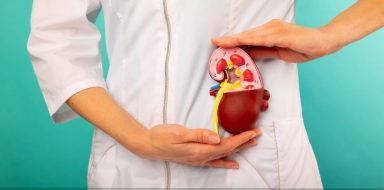Sacral Nerve Stimulation for Overactive Bladder
Overactive bladder (OAB) is syndrome that causes a sudden need to urinate. The hallmark symptom of OAB is urinary urgency; most people also experience urinary frequency and needing to urinate overnight (nocturia), and some people also experience urinary incontinence.
Many people accept OAB as a symptom of aging. However, OAB is not normal and there are a variety of treatments that can help, including sacral nerve stimulation.
What is Sacral Nerve Stimulation?
Sacral nerve stimulation (SNS) is one treatment. It is typically prescribed when other treatment options, such as medications, lifestyle changes and pelvic exercises have failed.
SNS involves the implantation of a device onto the lower part of the spinal column, the sacrum. This device functions similarly to a pacemaker – it uses electrical stimulation to improve OAB symptoms.
SNS implantation typically requires a test drive – the device is worn externally for several weeks to determine if it is effective for you. To do this, a tiny cut is made on the lower back, allowing the provider to feed a tiny wire close to the sacrum. This test is performed for three to five days.
If the test drive does not show at least a 50% improvement in symptoms, a different test is performed. The next test is more invasive and is implanted during a minor procedure. If this test shows 50% improvement in symptoms, you will then proceed to permanent implantation.
Once the test drive proves effective, a permanent device will be placed. This involves a surgical procedure. After the procedure, a handheld programmer will allow you to adjust the level of stimulation.
How Does Sacral Nerve Stimulation Improve OAB Symptoms?
SNS is placed on the sacral nerve. This nerve carries signals from the bladder, the brain and the spinal cord that let you know when you need to urinate. When the sacral nerve is working on overdrive, OAB symptoms are more likely to occur. The SNS device helps to block these impulses.
Though SNS may not stop every episode of urinary urgency and incontinence, it is likely to improve symptoms dramatically.
Pelvic floor exercises can help those living with overactive bladder strengthen their bladder and increase their bladder and bowel control.
Benefits of Sacral Nerve Stimulation
SNS has a myriad of benefits!
1. Minimal Side Effects
Though SNS requires a surgical implant placed through an invasive procedure, the side effects are considered minimal. In fact, most people do not have any side effects.
The most common side effect is infection at the device implantation site; this occurs in approximately 3% to 4% of cases. It is important to note that any surgical procedure carries a risk of infection.
Occasionally, mechanical failure can occur. If this occurs, the device can typically be reprogrammed.
Technical problems, lead movement and adverse stimulations can occur. However, these side effects are considered rare and can easily be resolved.
Pain at the insertion site is not expected, though slight soreness may occur for several weeks postoperatively.
2. Reversible Treatment
Though most people find that any benefits outweigh the possible side effects, the system is reversible. This means that the system can be removed through a minor surgical procedure. SNS can be discontinued without any permanent damage to the nerves.
3. Safe for MRIs
Magnetic resonance imaging (MRI) has been contraindicated with SNS implants in the past. This was because older models of SNS used lead. New models are considered MRI-safe. However, there are other treatments that are still considered incompatible with SNS, such as diathermy.
4. Lengthy Battery Life
The SNS device operates using a battery, which is part of the system. Eventually, the battery may die or begin to lose effectiveness. Fortunately, most batteries last 5 to 10 years, pending the amplitude of the signal as well as if the device is used continuously or intermittently.
5. Reduction in Symptoms
In a 2016 literature review published in Research and Reports in Urology, researchers evaluated the effectiveness of OAB. Here are various statistics pertaining to the research:
- A 1997 study evaluated the effectiveness against urge incontinence, where 90% of study participants had at least a 50% improvement of symptoms as shown by the participants voiding diaries.
- Another study evaluated 41 urge incontinence patients over a three-year period. The researchers found that, even after three years, 59% of study participants had over 50% reduction in incontinence events. 46% had no incontinence episodes.
- A study evaluated the number of urinary voids per day; this study found that the average voids decreased from 16.1 voids to 8.2 voids per day.
- Even more promising is the effect of SNS on patients with neurological disorders, such as Parkinson’s disease, multiple sclerosis and spinal cord injury. Research indicates that, for those with neurological disorders, symptoms improved after two years, regardless of symptom relation to that neurological disorder.







